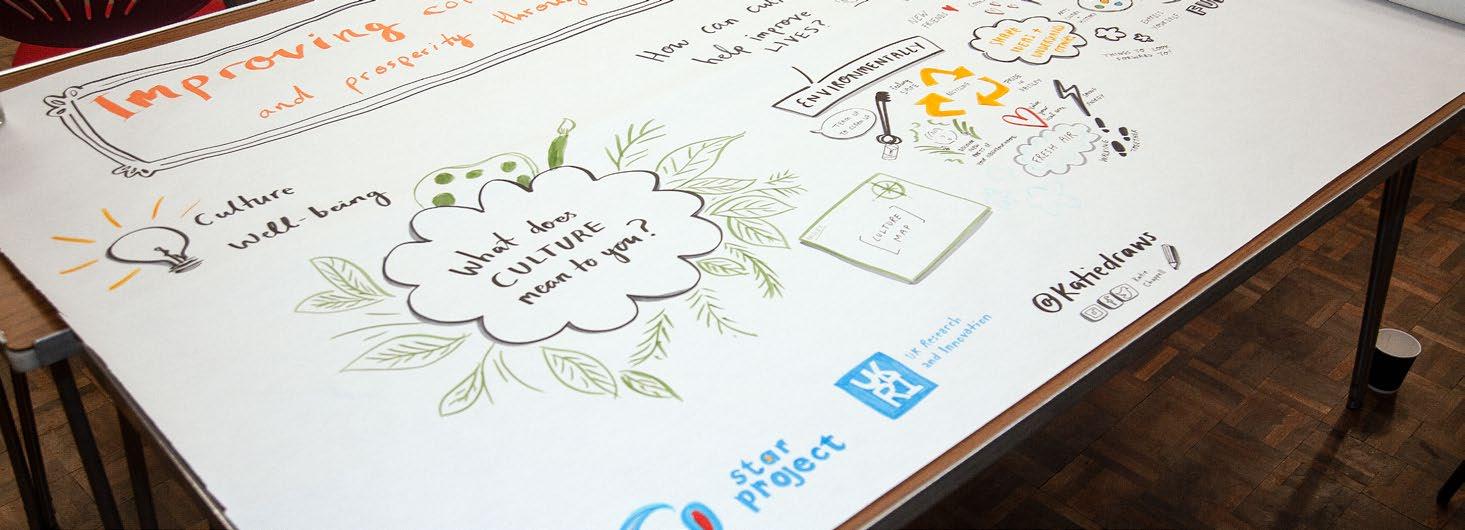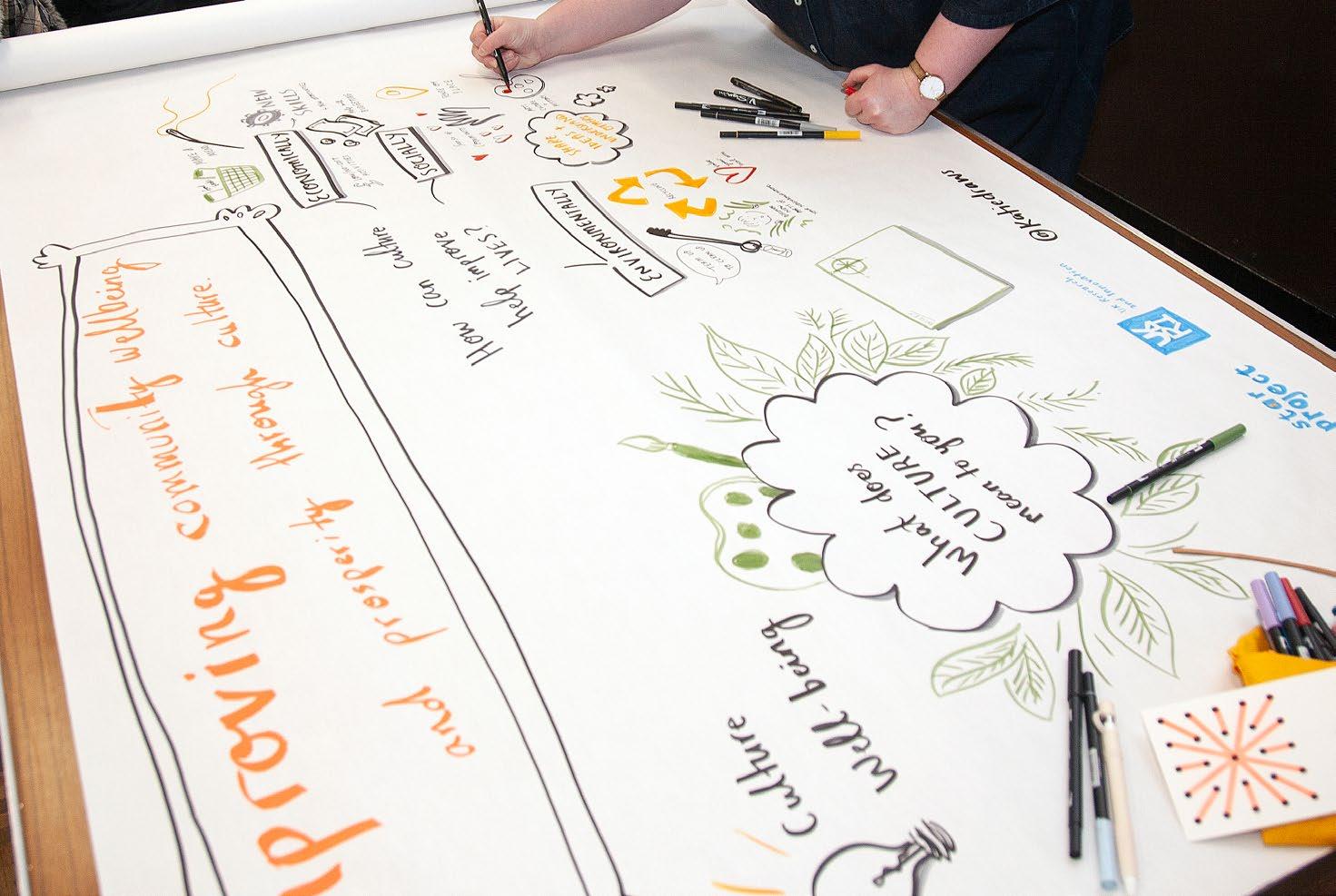
9 minute read
2.0 Poverty – a note on definitions
from The Role of Arts & Culture in Lifting Communities Out of Poverty, A Review of Evidence
by ccse_uws
The Role of Arts and Culture in Lifting Communities Out of Poverty: A Review of Evidence
1.0 Introduction
Advertisement
The purpose of this evidence review is to present an overview of the available academic and grey literature that identifies and analyses evidence relevant for understanding the contribution of arts and culture to the alleviation of poverty (see particularly Sections 4.0, 4.1, 4.1.1-4.1.4). The review was conducted using search terms focussing on the themes of “art” and “arts,” “culture” and “poverty” alongside related terms and their proxies. Further, the reference lists associated with these sources were interrogated to identify other relevant material for inclusion in the review.
Literature searches were initially undertaken using the terms “art,” “culture” and “poverty” / “poverty alleviation” alone. It was immediately clear that the literature that directly connects these terms has primarily developed within the context of (sustainable) development, often this work examines processes ongoing within developing and transitioning economies (i.e. Hagg, 2006; Sagina, 2005; Sim, 2017). Literature presenting analyses of data collected in the UK or, which reflects Europe-focused policy agendas and projects, generally does not utilise a contextualisation that associates the realms of art, culture and poverty alleviation overtly.1 While macro-economic analyses which echo those made for developing country contexts are evident (i.e. ACE: 2014), proxy indicators which – taken together – suggest that communities or individuals are likely to live in financially constrained circumstances, are preferred. Such indicators are focussed around measures of likely “social inclusion,” and “social exclusion” and include metrics such as “employment,” “education,” “wellbeing” and “personal development”.2 Notably, however, it is also clear that, equating “employment” with prosperity or – at least – the absence of poverty, is not unproblematic (i.e. Bakare: 2020; ACE; 2014; Inman 2020). In an attempt to uncover relevant literature with an explicit focus on “material poverty,” the term was added to the keyword combination searches.
These initial searches demonstrate the fluidity of the term ‘poverty,’ evidencing the variety of ways in which it is defined and, utilised to frame discussions analysis or evaluation. For the purposes of this review it is useful to address these conceptual issues prior to reviewing any of the extant literature on arts, culture and poverty alleviation. So doing highlights the challenge of harnessing the impetus generated by arts and cultural interventions to address issues of ‘poverty’ effectively. It also points towards the ways in which careful attention to the parameters of the term at a project’s outset might accrue increased benefit over the lifetime of the intervention and beyond.
1 Rather, literature returned for searches including terms or combinations of terms “arts,” “culture” and “poverty” often focussed on the social behaviour, cultural tools and constraints informing the day-to-day actions of people and communities living in poverty (i.e. Small et al, 2010).
2 See Jermyn for a list of ‘claimed impacts of the arts’ compiled from a survey of literature on arts projects and their evaluation (Jermyn, 2001: 13-14). For a summary list of studies which examined the impacts of arts participation summarising methodologies used and impacts identified see Jermyn (2001:14-15).
The term ‘poverty’ has both a broad usage and connotations, and a particular history, modern usage and associated discourse in domestic and international policy. It often sits alongside other terms including ‘inequality’, ‘disadvantage’ and ‘deprivation’; however, these terms frequently refer to a wider set of negative conditions, factors and experiences. Overall, the term poverty is most specific and codified in relation to the material circumstances in which people live. The Joseph Rowntree Foundation (JRF) offers the following definition of poverty:
‘When a person’s resources (mainly their material resources) are not sufficient to meet their minimum needs (including social participation).’ (Goulden & D’Arcy, 2014: 3)
Goulden and D’Arcy go on to add detail and context to this definition, pointing out that concepts like ‘minimum needs’, for example, are subject to all sorts of variables, including the role of the state and the market, the costs of goods and social norms. Thus, the definition itself is complex and subject to a variety of factors when applied in different contexts; however, at its heart is the relationship between the resources which people have available to help them meet their needs (which may, for many, be primarily their income) and the costs of meeting those needs. Goulden and D’Arcy argue that the causes and impacts of poverty are important to acknowledge and are strongly related – including factors such as low educational attainment, unemployment, exclusion – but that conflating these issues with poverty is unhelpful. Similarly, these authors identify that issues like social mobility, well-being or inequality are also related to poverty, but that conflating or using these terms interchangeably dilutes understanding of poverty as a key concept, and may limit the clarity of any policy response (2014).3
This elision or conflation of poverty with other terms and issues reflects several different things. Goulden and D’Arcy acknowledge that:
‘It would be easy to make the mistake of thinking that all good things go together, not simply as a conceptual or philosophical question, but in terms of thinking about policy interventions and making sure measures relate to anti-poverty policies.’ (Goulden & D’Arcy, 2014:7)
They are reflecting on a well-meaning perspective in which gathering together not just poverty but other related issues occurs as a desire to acknowledge the full gambit of challenges, and attempt to solve them together. Stewart and Roberts (2019) identify a similar tension in navigating the use of the term poverty in approaches which also advocate for acknowledging multi-dimensional approaches to measurement. They highlight, for example, conceptions of poverty within development literature, where wider deprivations beyond material resources are more routinely included in the literature, and in approaches to measurement.4
3 Black et al (ND, 7-8) recognise both the challenge and the importance of separating out different realms of poverty, noting the Welsh government’s identification of 3 dimensions of poverty: income poverty, service poverty and participation poverty. The Welsh government’s action plan was based around this typology.
4 This is certainly reflected in the literature uncovered in the process of researching this review. For example, many of the sources returned debated the usefulness of social inclusion as a guide for policy (Jermyn, 2001) or acknowledged its utility (i.e. Goodlad et al, 2002; Barraket, 2005; Jermyn, 2001) but debated definition. While the markers of social exclusion were delineated (i.e. Long et al, 2002), they were recognised as being ‘linked to poverty but not synonymous with it’ (Jermyn, 2001:2). In other studies, the appropriateness of positioning arts (GLAM) institutions as ‘agents of social inclusion’ (Belfiore, 2002:103) is problematized (i.e. Belfiore, 2002; also, McPherson, 2006; Barnes & McPherson, 2019; Sandell, 1998). The accumulation of social capital is linked to involvement in arts and cultural activity (i.e. McClymont et al, 2020; Gould 2001). In these analyses, this range of social markers is debated and discussed with reference to poverty and access but it is not clear that material poverty can be necessarily effectively addressed though these channels. The challenge of capturing and measuring the effects of arts and culture interventions is widely acknowledged (i.e. Matarasso, 1997; ACE, 2014; Kay, 2000).
When we look at formal measurements of poverty, it is possible to recognise the way in which definitions - which are either too simplistic or too broad - can create space (or perhaps cover) for particular political and ideological framings of poverty. Measurements of poverty, both domestically and internationally, often involve setting a line beneath which a household - or individual - may be termed as ‘living in poverty.’ The difference between absolute and relative measurements, for example, is not just a technical one but indicates conceptual (and potential ideological) variance too. Francis-Devine (2020) notes that the use of both absolute and relative indicators, with commonly used measures being either the relative or the absolute low income, (which the government in the UK defines as living in households with income below 60% of the median in that year). The ‘official’ statistics on poverty in the UK come from the Department for Work and Pensions’ Households below average income (HBAI) statistics, which looks at both low income and material deprivation. Jefferson (2018) puts these different measures into some global context when he notes that ‘many developing countries’ use an absolute measure, and that the US is unusual as a high income country which also uses an absolute poverty line.5
In 2016 the UK government removed indicators for low income and material deprivation from the official child poverty measurement (although the government is still required to publish this data annually), replacing them with other indicators of household ‘worklessness’ and children’s educational attainment; the aim was to remove those measurements relating to material resources. Stewart and Roberts suggest that even where international practices may prefer multi-dimensional approaches (e.g. including educational attainment or other wellbeing indicators), they do so in addition to indicators on material resources (i.e. income and material deprivation). In their review of consultation responses, Stewart and Roberts found that the large majority of ‘experts’ (including local authorities, charities, front-line services and academic researchers) were not in favour of the removal of indicators of material resources. They conclude that:
‘Poverty measurement is highly political: what is measured and reported on is what enables governments to be held to account, and in turn drives policy [….].Responses to the 2012–2013 consultation reveal concern that to broaden measurement is to detract attention away from income poverty, and away from structural drivers of poverty towards individual failings, just when government benefit reforms are putting pressure on material resources in low income households with children.’ (Stewart & Roberts, 2019)
In 2018, an independent commission – the Social Metrics Commission, involving several key independent organisations including the Legatum Institute, Joseph Rowntree Foundation and others – launched a report in which a new framework for measuring poverty in the UK was proposed (Social Metrics Commission, 2018). The issue of whether measures such as households with income below 60% of the median are the right gauges of material resources continues to be debated. The Joseph Rowntree Foundation, for example, produces its own metrics on poverty including work around a minimum income standard that is based on research which asks the public what they consider households need in order to reach a minimum socially acceptable standard of living.
Despite debates on definitions and measurements, poverty is a key policy concept. Eradicating poverty is the first of the United Nations’ 17 sustainable development goals, listed separately from a range of other areas like well-being and education. The Poverty Alliance in Scotland identifies ‘adequate incomes’ as the first of its four goals. In the context of exploring how arts and cultural interventions engage with poverty, what we can observe from this brief overview is: • The contested nature of the concept, and associated challenges with definitions and measurements • That this contestation is often political and ideological • That, if we take the narrower definition of poverty – even within a wider multi-dimensional landscape so that other deprivations (which are more properly understood as the effects of poverty) are also recognised – the core challenge is substantial, and speaks to the ways in which we organise our societies and economies.
5 Stewart and Roberts (2019) briefly discuss absolute versus relative poverty indicators, and summarise the debate about the two approaches as ‘overplayed’ and ‘sterile’.







